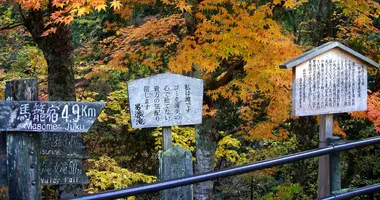Todaiji Temple 東大寺
- Published on : 16/10/2020
- by : Japan Experience
- Youtube
Todaiji incites interest by its imposing statue of Buddha, its status as the first sacred Buddhist site in the province can not be put aside. The grandeur of this site commands respect.
Todaiji, Nara
Todaiji Temple, situated a short walk from the center of Nara, in Nara Park, is Nara's most popular tourist attraction and a UNESCO World Heritage Site.
Todaiji, along with Kofukuji and Horyuji, make up the "Big Three" must-see temples of Nara.
Todaiji Temple is a complex of buildings that includes the world's largest wooden structure, the 48m (157 foot)-high Daibutsu-den, built in 743 which houses the 15m (49 foot) gilt bronze Daibutsu (Great Buddha), cast in 749: also the largest of its kind in the world.
History of Todaiji Temple
Founded in 745 by the Emperor Shomu, the vast temple at Todaiji was constructed as a symbol of imperial power, and took over 15 years to complete at great expense.
The main hall, which houses the colossal bronze Buddha statue within, remains the world's largest wooden building, though the present structure - rebuilt in 1709 - is only two thirds the size of the original.
The designer of the original Buddha was a Korean artist from the Paikche Kingdom, Kuninaka-no-Kimimaro.
Todaiji is the headquarters of the Kegon sect of Japanese Buddhism and Vairocana Buddha is considered by followers of the sect to be the spiritual body of the historical Buddha - Gautama Buddha or Sakyamuni in Japanese terminology.
After achieving enlightenment in what is now the small town of Bodh Gaya in Bihar, northern India, the Buddha sat for a week in deep meditation and it is this pose that is represented in the giant statue.
Todaiji Temple Buildings
Visitors to Todaiji enter the temple through the massive Nandaimon Gate (Great South Gate) - rebuilt in the 13th century - and known for its giant guardian gods or nio, 7m-tall wooden statues protecting the temple within from evil.
Opened in 2011 is the Todaiji Museum, a modern building close to Nandaimon Gate, which hosts rotating exhibitions of treasures from the temple, including Buddhist statuary and religious art.
The Great Buddha Hall (Daibutsuden) houses Japan's largest bronze statue - a darkened figure of the Cosmic Buddha (Dainichi Nyorai). The statue weighs 500 tons and is 16m tall - a masterpiece of Tempyo Period (729-764) art.
Several attempts at casting the Buddha failed before success was finally achieved in 752. Ambassadors from as far away from India, Persia and China attended the dedication ceremony and the gifts they brought with them were kept in the Shoso-in treasure house, behind the hall.
Little remains of the original 8th century statue, however, which has been damaged in fires and earthquakes and subsequently re-cast.
Only on New Year's Eve and New Year's Day are the upper doors, in front of the face of the Great Buddha, opened at the temple; Worshipers can thus pray to the Buddha from the outside of the temple on this day.
West of the Daibutsuden is the Kaidanin, which was set up in 754 as Japan's premier ordination hall for new monks. The present building dates from the Edo Period (1603-1858) but it contains some ancient and exquisite clay statues of the Shitenno or Four Heavenly Kings.
The Bell Tower at Todaiji dates from 1210 and is believed to have been built by the Zen priest Yosai (1141-1215). The bell weighs an incredible 26.3 tons.
To the east of Todaiji on the slope of a hill are the Nigatsu-do and Sangatsudo (Hokke-do) sub-temples of Todaiji. The Nigatsu-do is the site of the annual Omizutori repentance and purification rituals held from March 1-14. Priests carry long, flaming torches up to the balcony of Nigatsu-do and hold them over the crowds below. The burning embers that rain down on the onlookers below are believed to bestow good fortune for the coming year.
Sangatsudo (Hokke-do) contains a number of extremely important statues including a 3.6 meter-tall, dry lacquer image of Fukukenjaku Kannon, who strives to save all souls from suffering. The image is surrounded by 14 other statues including flanking clay images of Nikko-Bosatsu and Gakko-Bosatsu, both National Treasures.
Address, timetable & access
Todaiji, Nara
Address
406-1 Zoshicho
630-8587
Japan
Phone
+81 (0)742 22 5511Timetable
8 am-4.30 pm or 5pm daily from November to March and 7 am-5 pm or 5.30 pm April-October.Price
A joint ticket for the Great Buddha Hall at Todaiji and the Todaiji Museum is presently 800 yen or it is 500 yen to enter the Great Buddha Hall.Access
Todaiji is north east of Kofukuji and north of Nara National Museum. Todaiji is a 30 minute walk from Kintetsu Nara Station. Todaiji is also around a 45 minute walk from JR Nara Station. Nara Kotsu buses run to the temple from both stations including the yellow Nara City Loop Line Bus #2, the #70, #72, #97 and the #160; get off at Todaiji Daibutsuden bus stop.Website
http://www.todaiji.or.jp/english/index.html
















